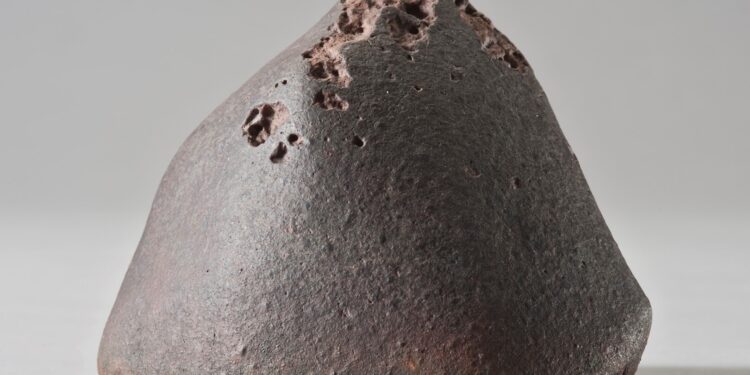Meteorite El Médano 128, an ordinary chondrite (group L), discovered in the Atacama Desert in 2011 by a team of researchers from the Center for Research and Teaching of Environmental Geosciences (CEREGE – Aix-Marseille University/CNRS / INRAE/IRD). Credit: Jérôme Gattacceca, CNRS, CEREGE
An international team led by three researchers from the CNRS, the European Southern Observatory (ESO, Europe) and Charles University (Czech Republic) has succeeded in demonstrating that 70% of all known meteorite falls come from just three young asteroid families. These families were produced by three recent collisions that occurred in the main asteroid belt 5.8, 7.5, and about 40 million years ago.
The team also revealed the sources of other types of meteorites; Thanks to this research, the origin of more than 90% of meteorites has now been identified. This discovery is detailed in three articles, the first of which was published on September 13, 2024 in the journal Astronomy and Astrophysicsand two new articles which will be published on October 16, 2024 in Nature.
An international team of researchers has shown that 70% of all known meteorite falls come from three young asteroid families (Karin, Koronis and Massalia) formed by collisions in the main asteroid belt 5.8, 7.5 and about 40 million years ago. The Massalia family has notably been identified as being at the origin of 37% of known meteorites.
If more than 70,000 meteorites are known, only 6% had been clearly identified by their composition (achondrites) as coming from the Moon, Mars or Vesta, one of the largest asteroids in the main belt. The source of the remaining 94% of meteorites, the majority of which are ordinary chondrites, had remained unidentified.
Why are these three young families the source of so many meteorites?
This can be explained by the life cycle of asteroid families. Young families are characterized by an abundance of small fragments left by collisions. This abundance increases the risk of collisions between fragments and, coupled with their high mobility, their flight out of the belt, possibly towards the Earth. Asteroid families produced by older collisions, on the other hand, are “exhausted” sources of meteorites.
The abundance of small fragments that once constituted them naturally eroded and finally disappeared after tens of millions of years of successive collisions and their dynamic evolution. Thus, Karin, Koronis and Massalia will inevitably coexist with new sources of meteorites from more recent collisions and will eventually give way to them.
Polarized transmitted light image of the ordinary chondrite (group H) San Juan 029, found in the Atacama Desert in 2008 by a team of CEREGE researchers. Image width 3 mm. Credit: Jérôme Gattacceca, CNRS, CEREGE
A method for tracing the family tree of meteorites and asteroids
This historic discovery was made possible through a telescopic study of the composition of all major asteroid families in the main belt, combined with state-of-the-art computer simulations of the collisional and dynamic evolution of these major families. This approach has been extended to all families of meteorites, revealing the primary sources of carbonaceous chondrites and achondrites, which are added to those of the Moon, Mars and Vesta.
Thanks to this research, the origin of more than 90% of meteorites has now been identified. It also allowed scientists to trace the origins of kilometer-sized asteroids (a size that threatens life on Earth). These objects are the subject of numerous space missions (NEAR Shoemaker, Hayabusa1, Chang’E 2, Hayabusa2, OSIRIS-Rex, DART, Hera, etc.).
It appears in particular that the asteroids Ryugu and Bennu, recently sampled by the Hayabusa2 (Japanese Aerospace Exploration Agency JAXA) and OSIRIS-REx (NASA) missions and studied in laboratories around the world, particularly in France, would come from the same parent. asteroid like the Polana family.
The origin of the remaining 10% of known meteorites is still unknown. To remedy this, the team plans to continue its research, this time focusing on characterizing all young families formed less than 50 million years ago.
More information:
M. Brož et al, Source regions of carbonaceous meteorites and near-Earth objects, Astronomy and astrophysics (2024). DOI: 10.1051/0004-6361/202450532
Michaël Marsset, The Massalia family of asteroids as the origin of ordinary L chondrites, Nature (2024). DOI: 10.1038/s41586-024-08007-6. www.nature.com/articles/s41586-024-08007-6
Quote: Unlocking cosmic origins: Researchers trace 70% of meteorites to 3 asteroid families (October 16, 2024) retrieved October 16, 2024 from
This document is subject to copyright. Except for fair use for private study or research purposes, no part may be reproduced without written permission. The content is provided for informational purposes only.



